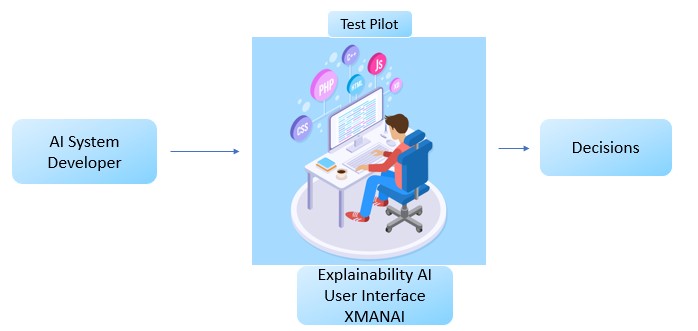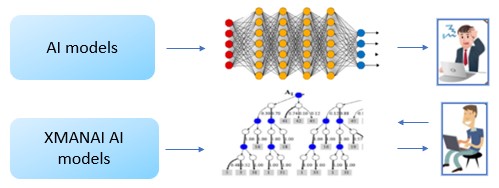XAI in Manufacturing

The implementation of Artificial Intelligence (AI) in the manufacturing domain enables higher production efficiency, outstanding performance, and safer operations, leveraging powerful tools such as deep learning and reinforcement learning techniques. We have only few insights about how AI systems work. XMANAI should transform that AI that is now too complex for the human factor to understand; and unveil what lies behind deep learning models and to make AI models step-by-step understandable.
XMANAI technology enables to examine solutions to optimise different tasks along the industrial workflow, including Assembling/Quality testing, Default detection, Maintenance prediction, Logistic and End-to-end chain supply. According to the 4 demonstrators implemented and their needs in the industry, XMANAI will provide an AI platform powered with explainability focusing on Product Demand Planning, Production Optimization, Product/Process Quality Optimization and Smart Semi-autonomous Hybrid Measurement Planning use cases.

Product Demand Planning & Measurement Planning
A combination of factors has made demand planning a complex activity:
- Timely availability of data: Multiple data sources lead to delays in data collection for forecasting, which ultimately impacts the demand plan.
- New product launches: Accurately forecasting demand for the new products has always been a challenge
- Lack of collaboration: Siloed planning and lack of cross-functional communication leads to loss of important information midway, and ultimately results in sub-optimal plans
- Customer preferences: Traditional demand forecasting methods rely on historical patterns to generate predictions
Forecasting demand is one of the cores of XMANAI platform, which will allow managers to design better strategies, make wise changes and compete effectively in the market. Demand forecasting employs machine learning algorithms to perform time-series analysis XMANAI is working to solve the understanding of this algorithms even if the time series analysis is hard to be interpreted. XMANAI will help industry and metrology in their daily production planning and the human factor to receive recommendations in the constraints, reduce study and queries time produced by the factory operators. Besides, will provide metrology the possibility to reuse the knowledge provided by blue collar workers to reduce time to prepare the optimal measurement plan.
Production Optimization & Process Control
With the aim of improving production, Artificial Intelligence has found new ways to mobilize the possibility to improve the methods used in manufacturing environments. In certain cases, it is really important to know what the basis was for making certain decisions and this is where explainable AI could play an important role. (Rao & Mane, 2019)
Typical explanations in this field could include feature attributions showing what factors contribute more to the final outcome, or rule-based explanations which can be especially valuable to domain experts. XMANAI will work on the demonstrators on providing an explainable AI with the aim that the developed algorithms and the human factor work together.
AI based optimization techniques for demand-driven manufacturing, hybrid approaches for production planning and scheduling, intelligent systems for manufacturing production and optimization in the industry 4.0 are sometimes too complex to understand. In this context, XMANAI, will improve and enhance the production inside the industry plant through the technical partners and advanced techniques on Machine Learning and Deep Learning models.
XMANAI aims to achieve active feedback for the calculation of the volume and measurement constraints of the different production lines where the goal is to assign human and raw resources to optimize production time.

A high degree of automation and human-machine collaboration is usually employed in modern industrial settings. Processes that compose the entire length of a manufacturing production line are constantly monitored using multiple sensors and operationally controlled via multiple actors under digital twin technology (e.g. (Reimann & Sziebig, 2019)). The operational framework controlling the workflow should include a friendly interface for the operator to monitor the process and comprehend the actions decided by AI components using explainability techniques, while being able to intervene manually when necessary.
Product/Process Quality Optimization & Maintenance
Industrial product quality is closely inspected along the production and assembly line, from the inflow of raw material to the outflow of the final product. Thanks to the implementation of XMANAI the human factor will be assisted by digital tools in augmenting and supporting the human worker in cognitive industry process. It will increase the speed of the analysis and guide the engineers to plan the strategy or possible errors. XMANAI will empower novel metrologists and quality engineers with deep knowledge and better understanding of high-performance quality control strategies and optimum coordinate measurement machine configuration and set-up. High customisation of metrology workflows to complexity and diversity of geometrical and dimensional tolerance control will be democratise across a wider range of blue and white collar workers with access to an informed decision process powered by human-centric collaborative AI.
In the context of advanced asset maintenance, the constant feedback on system diagnostics and machinery conditions in modern industrial settings, along with historical data on machine failures, provides manufacturers with the opportunity to operate under condition-based, accuracy and knowledge by the operators.
XMANAI platform should reduce emergency maintenance allowing a better scheduling of activities, decreasing alarms and activities done in emergency conditions, and contributing to the overall production quality improvement.
The graph AI models to be explored trained and evaluated in XMANAI will allow simulating different scenarios for operator collaborative maintenance to support at runtime to operators about human-AI collaborative troubleshootings for maintenance tasks.

